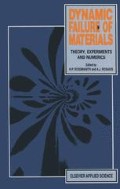Abstract
A shearing interferometric method (CGS) is used to study dynamic crack-tip fields in both transparent and opaque media. CGS is a full-field optical technique that provides real-time fringes representing crack-tip deformation or stress state. The results of the experiments are interpreted on the basis of a newly developed transient higher-order asymptotic analysis. The good agreement between the experimental results and the transient higher-order asymptotic analysis clearly indicates that the contribution of the non-singular terms to the total stress and deformation fields is significant.
Access this chapter
Tax calculation will be finalised at checkout
Purchases are for personal use only
Preview
Unable to display preview. Download preview PDF.
References
Balas J., and Drzik, M., (1983) Staveb, Cas., 31, c 6/7, VEDA, Bratislava.
Tippur, H.V., Krishnaswamy, S., and Rosakis A.J., (1989a), “A Coherent Gradient Sensor for Crack-Tip Deformation Measurement: Analysis and Experimental Results,” GALCIT SM-Report 89-1, California Institute of Technology, (to appear in the International Journal of Fracture).
Tippur, H.V., Krishnaswamy, S., and Rosakis A.J., (1989b), “Optical Mapping of Crack Tip Deformation Using the Methods of Transmission and Reflection Coherent Gradient Sensing,” GALCIT SM-Report 89-11, California Institute of Technology, (submitted to the International Journal of Fracture).
Freund L.B., and Clifton R.J., (1974), “On the Uniqueness of Plane Elastodynamic Solutions for Running Cracks,” Journal of Elasticity, vol. 4, No. 4, pp 293–299.
Rosakis A.J., and Ravi-Chandar K., (1986), “On Crack-Tip Stress State: An Experimental Evaluation of Three-Dimensional Effects,” International Journal of Solids and Structures, vol. 22, No. 2, pp 121–134.
Nigam H., and Shukla A., (1988), “Comparison of the Techniques of Transmitted Caustics and Photoelasticity as Applied to Fracture,” Experimental Mechanics, vol. 28, No. 2, pp. 123–133.
Dally J.W., Fourney W.L., and Irwin G.R., (1985), “On the Uniqueness of Kid — a Relation,” International Journal of Fracture, vol. 27, pp 159–168.
Knauss W.G., and Ravi-Chandar K., (1985), “Some Basic Problems in Stress Wave Dominated Fracture,” International Journal of Fracture, vol. 27, pp 127–143.
Freund L.B., and Rosakis A.J., (1990), “The Influence of Transient Effects on the Asymptotic Crack-Tip Field During Dynamic Crack Growth,” Eleventh National Congress of Applied Mechanics, Tucson, Arizona, May 1990.
Krishnaswamy, S., Rosakis, A.J., and Ravichandran G., (1988), “On the Extent of Dominance of Asymptotic Elastodynamic Crack-Tip Fields; Part II: Numerical Investigation of Three-Dimensional and Transient Effects,” GALCIT SM-Report 89-22, California Institute of Technology, to appear in the Journal of Applied Mechanics.
Kalthoff J.F., (1983), “On Some Current Problems in Experimental Fracture Mechanics” in ‘Workshop on Dynamic Fracture,’ edited by Knauss W.G. et al., California Institute of Technology, pp 11–35.
Ravi-Chandar K., and Knauss W.G., (1984), “An Experimental Investigation of Dynamic Fracture-I: Crack Initiation and Arrest,” International Journal of Fracture, vol. 25, pp 247–262.
Rosakis A.J., Duffy J., and Freund L.B., (1984), “The Determination of Dynamic Fracture Toughness of AISI 4340 Steel by the Shadow Spot Method,” Journal of the Mechanics of Physics of Solids, vol. 32, pp 443–460.
Zehnder A.T., and Rosakis A.J., (1989),, “Dynamic Fracture Initiation and Propagation in 4340 Steel Under Impact Loading,” International Journal of Fracture, (to appear).
Ravi-Chandar K., and Knauss W.G., (1987), “On the Characterization of the Transient Stress Field Near the Tip of a Crack,” Journal of Applied Mechanics, vol. 54, pp 72–78.
Krishnaswamy, S., and Rosakis, A.J., (1988), “On the Extent of Dominance of Asymptotic Elastodynamic Crack-Tip Fields; Part I: An Experimental Study Using Bifocal Caustics,” GALCIT SM-Report 89-22, California Institute of Technology, to appear in the Journal of Applied Mechanics.
Author information
Authors and Affiliations
Editor information
Editors and Affiliations
Rights and permissions
Copyright information
© 1991 Elsevier Science Publishers Ltd
About this chapter
Cite this chapter
Rosakis, A.J., Krishnaswamy, S., Tippur, H.V. (1991). Measurement of Transient Crack Tip Fields Using the Coherent Gradient Sensor. In: Rossmanith, H.P., Rosakis, A.J. (eds) Dynamic Failure of Materials. Springer, Dordrecht. https://doi.org/10.1007/978-94-011-3652-5_13
Download citation
DOI: https://doi.org/10.1007/978-94-011-3652-5_13
Publisher Name: Springer, Dordrecht
Print ISBN: 978-1-85166-665-2
Online ISBN: 978-94-011-3652-5
eBook Packages: Springer Book Archive

